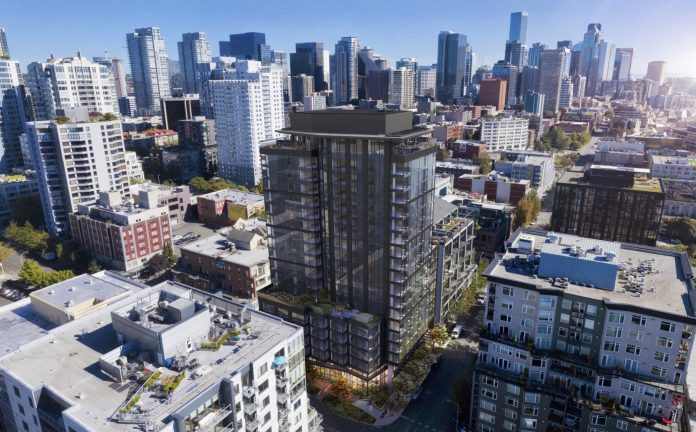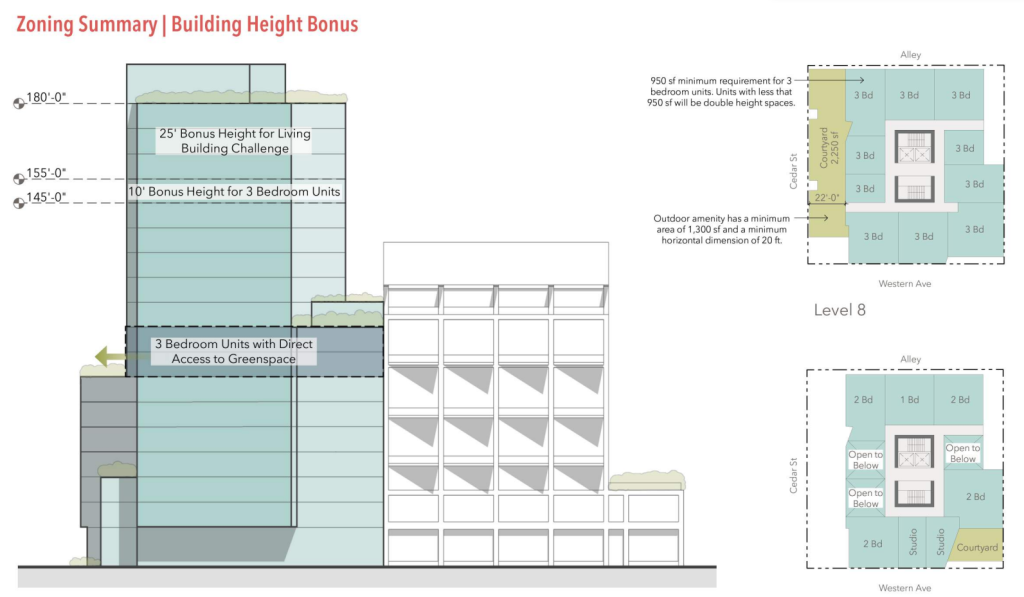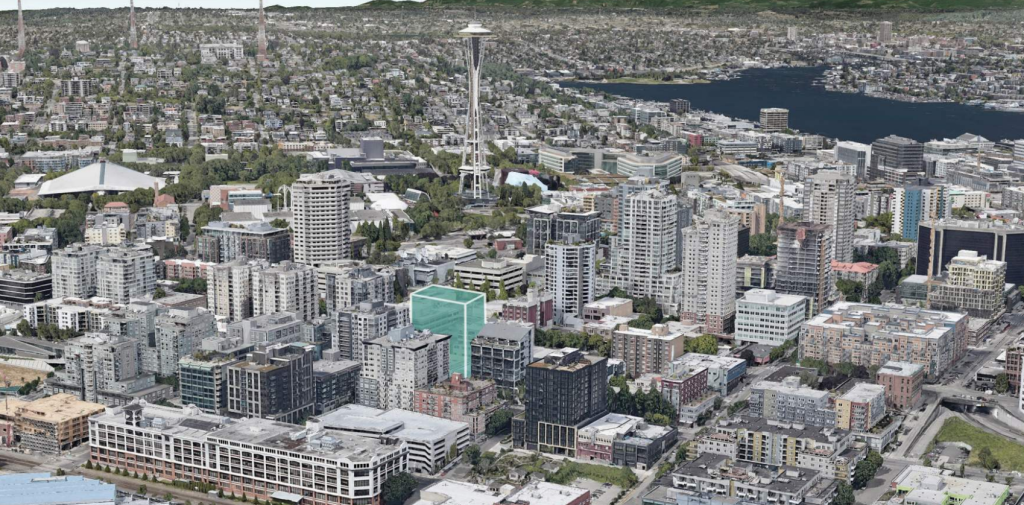
A group of Belltown residents have filed an appeal seeking to force a rigorous environmental review before the Seattle City Council could approve rules allowing a small number of taller, more environmentally friendly buildings in Downtown Seattle. The filing represents the latest saga in a long fight over a specific proposal to build a 19-story apartment building at the corner of Western Avenue and Cedar Street, but its implications could be much more wide-ranging.
The rules concern Seattle’s Living Building Pilot Program, which dates to 2009 and encourages developers to incorporate environmental sustainability elements into their buildings by offering a height bonus and additional floor area allowances. The pilot has been capped so far to just 20 projects, and 15 have already been enrolled, including the internationally recognized Bullitt Center in Capitol Hill.
Appellants worry new towers, even with their participation in the city’s top green building program, are not bird-friendly. “Increasing the number and density of tall buildings is likely to significantly adversely affect birds by increasing bird strike injuries and death,” the appeal claims.
Since 2020, Saratoga Capital has been trying to get approval to build a 19-story, 182-unit apartment building at 2616 Western Avenue under the pilot. The building was set to be awarded a 25-foot height bonus for meeting the Living Building standards and an additional ten foot bonus for including three-bedroom units, which are scarce in Downtown. After a lengthy design review process, the City eventually gave the green light for the project to move forward last year. But things didn’t stop there.

Within weeks, a so-called “Belltown Livability Coalition” filed an appeal; its primary representative, Pat Montanino, lists an address directly across the street from the planned development in the group’s filings at the Hearing Examiner. The first appeal the group filed in 2023 argued that the building shouldn’t be granted additional development rights under the Living Building pilot because of an existing provision in city code limiting buildings over 175 feet when their lots are less than 19,000 square feet. Earlier this year, Seattle’s Hearing Examiner Susan Drummond sided with the appellants, finding that the Living Building pilot doesn’t make a project exempt from that provision.
The Seattle Department of Construction and Inspections (SDCI) disagreed with the Hearing Examiner’s interpretation of the code, but nonetheless completed a Determination of Non-significance (DNS) for a code update that would have clarified that the Living Building pilot doesn’t have a minimum lot size. The Seattle City Council had been set to take up that update for adoption in early September.
However, early this week, the Belltown Livability Coalition filed another appeal, arguing that the City did not adequately study the impact of the proposed rule change, and its appeal puts front and center a claim that allowing taller buildings Seattle’s central core will be bad for birds. The appeal seeks to force SDCI to go through an environmental review process before advancing the policy update.
“Tall buildings adversely affect birds because birds fly into the sides of them and are injured or killed,” the appeal states. “The proposed code amendment would allow significantly taller buildings on smaller lots than the code currently allows. As a result, the proposed code amendment would not only allow taller buildings, but allow for those taller buildings to be more closely packed within the Downtown Mixed Residential zone.”

The appeal also alleges that SDCI needs to study the rule’s impact on aesthetics, light and glare, historic sites and landmarks, vehicular traffic, pedestrian traffic, public transit, emergency services, and utilities. This is a common tactic in land use appeals: to throw every possible category of issue at the Hearing Examiner and see if any of them stick. The appeal even argues that SDCI should more carefully weigh the impact of allowing additional people to live in one of the densest neighborhoods on the West Coast due to noise.
“People generate noise by talking, yelling, using speaker phones, and operating vehicles and equipment. Constructing tall buildings generates significant noise impacts, too. The proposed code amendment would increase these adverse noise impacts significantly,” it states. The appellants argue that the DNS is in violation of the State Environmental Policy Act (SEPA) and should be withdrawn.
Even if the appeal is dismissed as expeditiously as possible, its filing likely means a delay on City Council action of at least several months, likely pushing it into 2025 and along with it these 182 homes, along with any others that could be built elsewhere in downtown under the Living Building program.
Appeals like this have been common for decades as a way to stall individual projects, until the Washington State Legislature passed Senate Bill 5412, which categorically exempts infill development within the state’s urban areas from SEPA. And the delays from those projects came with real costs: an analysis by The Urbanist conducted in 2023 found that just in the area around Downtown Seattle, project-level appeals had delayed over 3,000 units of housing and over $39 million that those projects had been set to contribute to funding affordable housing in Seattle.
This code change, because it is not at the project level, is not specifically exempt from SEPA, opening the door to this specific appeal. However, that doesn’t mean the Hearing Examiner will find that it has merit.
For every dense building blocked in Seattle’s dense urban core, additional development pressures mount on the edges of the Puget Sound’s growth boundaries, causing more sprawl that ultimately drives up climate pollution and fails to protect the environment. But for the Belltown Livability Coalition, taking a wider-angle view is apparently for the birds.
Ryan Packer has been writing for The Urbanist since 2015, and currently reports full-time as Contributing Editor. Their beats are transportation, land use, public space, traffic safety, and obscure community meetings. Packer has also reported for other regional outlets including BikePortland, Seattle Met, and PubliCola. They live in the Capitol Hill neighborhood of Seattle.

